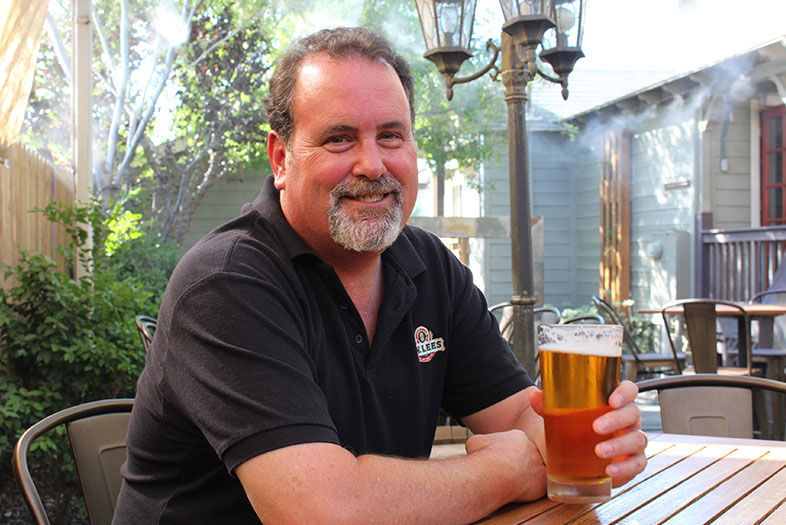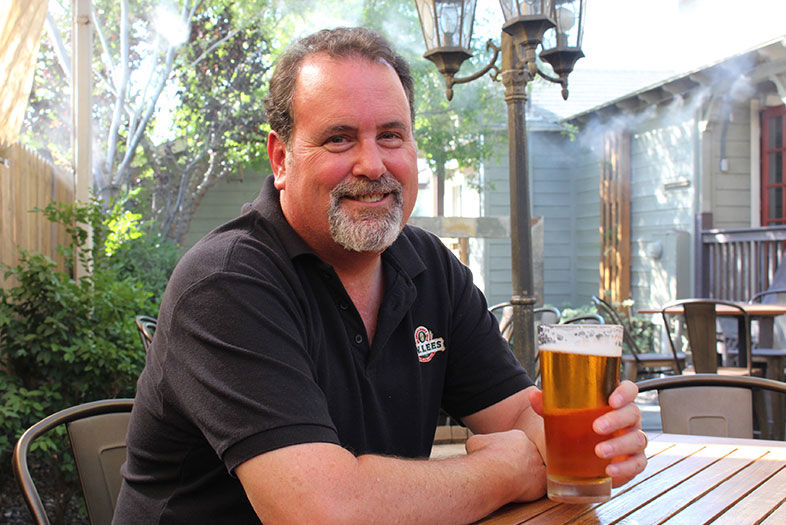For the past ten years, he was one of the three most recognized public faces of Stone Brewing Co. Along with co-founders Greg Koch and Steve Wagner, brewmaster Mitch Steele represented the very heart of Stone culture. He oversaw new recipe development, approved R&D, organized collaborations, and made sure that—no matter what Stone was doing—the company remained innovative.
On June 30, Mitch left Stone to pursue a new brewing venture. I sat down with him at a bar in Temecula and—while sipping Mother Earth’s Kismet IPA and Pizza Port’s Grandview Blonde— we talked about what his years at Stone meant to him, his experience with big beer, and what the next phase of his career is going to look like.
It’s been a few weeks now since you left Stone, have you enjoyed a little time off for vacation?
Oh, no! My last day at Stone was Thursday, June 30, and I started working for the new company Friday, July 1. So there was no break!
Before we talk about the new company, let’s talk about how you decided this was the right time to leave Stone.
I’m not sure I was ever comfortable saying it was the “right time” to leave Stone. It was just such a neat opportunity with the new company… I didn’t want to leave Stone. I wasn’t looking to leave Stone. It’s just that this was one of those opportunities—and it will become more clear when I can actually talk about it more—it was one of those opportunities that was going to set me up for my future and my family’s future, and where I want to retire—things like that. So it was those things, and also the fact that, you know, I’ve been doing the same job at Stone for ten years, and even though things have changed a lot over those ten years, in essence, it’s been the same job. Now this is a chance to get back to roots and start from the ground floor and really build something. And that’s something I’ve always wanted to do. When this opportunity showed up, I initially said no. I said I wasn’t interested—for a lot of reasons. I said I was very happy at Stone, I’ve got a daughter in high school and I’m not going to move her, and so on. But they were very persistent. They kept talking to me and, eventually, I said, well, this might be a good thing. This might be fun.
Looking back on your decade at Stone, the company obviously changed a lot during your tenure. It had phenomenal growth every year that you were there. So, looking back, are there things you are particularly proud of?
Oh, boy. Yeah! There’s a lot. Just growing from a 50,000-barrel-a-year brewery to a 350,000-barrel-a-year brewery— just being there for all of that was pretty crazy and pretty rewarding.
Some of the other things that really stand out for me are the collaboration series we did. Those were just fun. It was a chance for everybody involved to do something different from what they normally do, and a chance to have a great time just building a beer and brewing it and seeing the end result. We got to the point where we were doing five or six of those collaborations a year.
Do you have a favorite collaboration that stands out?
Yeah, a couple. I think Unapologetic IPA with Jamil Zainasheff (Heretic Brewing) and Julian Shrago (Beachwood BBQ) was one of my favorites. It was a double IPA, it wasn’t really too crazy, but it used some neat hops. They both said, if we three were going to collaborate, we really can’t do anything but a double IPA. So I said, fine!
I think the Highway 78 Scotch Ale we did with Jeff Bagby and Chuck Silva was also amazing. I also loved brewing with Wicked Weed; Luke and Walter are two of my favorite people in the business. The Suede Imperial Porter that we did with avocado, honey, and jasmine was also amazing—about three years ago—we did that with Tonya Cornett from 10 Barrel and Megan Parisi, who was working for a brewery called Blue Jacket out of D.C. at the time.
Before Stone, you were in New Hampshire with Anheuser-Busch. So you came to Stone from big beer. What are the things you feel you’ve learned being part of the San Diego craft beer community?
Oh man, I think the main thing is the whole mindset of not being afraid to take a chance—living with it if it doesn’t work, and just moving on. Learning and moving on. And another thing I learned was staying true to the brewer philosophy. The one thing about Stone that I really appreciated and was very thankful for was, when we decided to brew a beer, as long as it tasted great, I could do whatever I wanted. Greg and Steve would weigh in if they didn’t like the beer, and we’d change it, but in general they gave me tons of creative freedom. I never expected to have that walking in the door—I expected to have some—but the amount of freedom that they gave me was something I was very thankful for. It just taught me so much about how to put beers together and about what people like. I really learned about what works and what doesn’t work.
What are some of the new releases that you had a hand in right before you left?
Well, Wussie—the pilsner—was one of my “going away presents.” I‘m really proud of that beer and I’m really happy with the way it came out. We wanted to make it authentic but we also really wanted to make it “Stone.” I think we accomplished that. The Citrusy Wit and the 20th Anniversary, which is coming out in August, were the last ones that I really put together.
So let’s talk about what you can tell me about the new project.
I was approached by a couple of industry vets who have been out of the business for a while. They had partnered up with each other and wanted to start a brewery, and they wanted a third partner to be the brewmaster. We have a mutual friend—who I can’t name—he’s a guy who’s been in the business since the 1980s. I called him and asked if these two guys were legit. My friend told me they definitely were and that they wanted to really make a mark and do something special and different. They really want to make an impact.
There’s some pretty solid financial backing behind the project, from people who are not brewery people, so there’s that aspect of it as well. And the two guys I’m partnering with have really solid distribution and sales experience as well as logistics experience. So, they’re not brewing guys, but they have a lot of pretty varied experiences in the business.
I imagine this is also an opportunity for you to have a stake in the long-term success of the business.
Yeah, a little bit, and that was attractive to me, too. But the biggest thing was being able to start something. It’s exciting. It was kind of my retirement plan, even though I’m ten or fifteen years away from retiring, so when this thing came along I thought, well, this is kind of what I was looking to do eventually anyway.
Do you have a location already?
Not quite. But we’re very close.
Will your fans in San Diego eventually benefit from this new venture?
No. It’s going to be out of state. I’m going to stay in California for three years while my daughter is in high school, and after my daughter graduates, that’s when we’ll be looking to move.
You mentioned that the guys behind this new company want to do something really different. How is it going to be different?
Well, there’s going to be restaurants involved. They want to have really special destination spots. And their concept is to really make the entire visit an “experience.” They’re really taken with Stone, they really love what Stone has done, and they like what some of the other breweries, like Sierra Nevada in Asheville, have done. They really want to do something on that scale. Maybe not as big, but that kind of “cool” factor.
There’s also an opportunity to really impact the industry as a whole. I always looked at Greg Koch as somebody who worked to “convert the masses,” right? Well, where we’re going I think there’s an opportunity to do the same thing, and that excites me.
Are there any directions you plan on going in your position, from a brewing standpoint—new styles—that you weren’t able to do at Stone?
You know, my roots are Stone-style beers. That’s what I homebrewed. I don’t expect to be veering too far off of that path. I do expect that we’ll be doing a few more lagers—you know, Wussie was really the first one we did at Stone—so I’m looking forward to having the opportunity to brew a couple of lagers. My general inclination, though, is that I will be brewing pretty aggressive-style ales, kind of like what I did at Stone. I learned a lot at Stone about doing that. I mean, classic styles are great, but I’m not sure they’re going to have continued relevance. Just look at what’s happened with pale ales. You can’t find a pale ale anymore. It’s tragic. At this point, if I look at a beer list, the first thing I look for is a pale ale or a pilsner. I love .394. It’s a great beer. Just having a beer that’s got some hop character that isn’t 7% alcohol is kind of a nice thing.
“Honestly, I thought the session IPA craze was going to take off.”
Honestly, I thought the session IPA craze was going to take off. I mean, if you talk to brewers, the brewers all love it. And that’s usually a pretty good indication if something is going to succeed or not. But the problem is that people are still buying on alcohol. They’re still looking at alcohol content when they buy. The thing I learned about session IPAs is that people look at the alcohol content and equate that with price. So, when you’re brewing a beer that’s equivalent to a double IPA as far as the hopping, but the alcohol level is below 5%, people are going to balk at paying an IPA price for it, which is a shame. I think it’s a really neat style and I love it.
So, what’s the one thing you’re going to miss the most about San Diego once you’ve moved?
Oh, the people. There’s no doubt. All the people that I’ve gotten to know here, all the great brewers, all the great beer fans. Just the entire scene is full of great people.
Would you say it’s the best beer culture you’ve ever been in?
Yes, it is.
Of course, comparing it to New Hampshire…
Yeah, New Hampshire had a really good beer scene but it was very small! Boston had a good beer scene, but it was nothing like what we’ve got here in San Diego. But, even with all the great breweries and beer here, I’m going to miss the people more than anything. That’s what I’m going to miss. That’s just going to be really hard.

Have a Beer with Ex-Stone Brewmaster Mitch Steele
PARTNER CONTENT
Mitch Steele is forging a new path, post-Stone. | Photo: Bruce Glassman


















